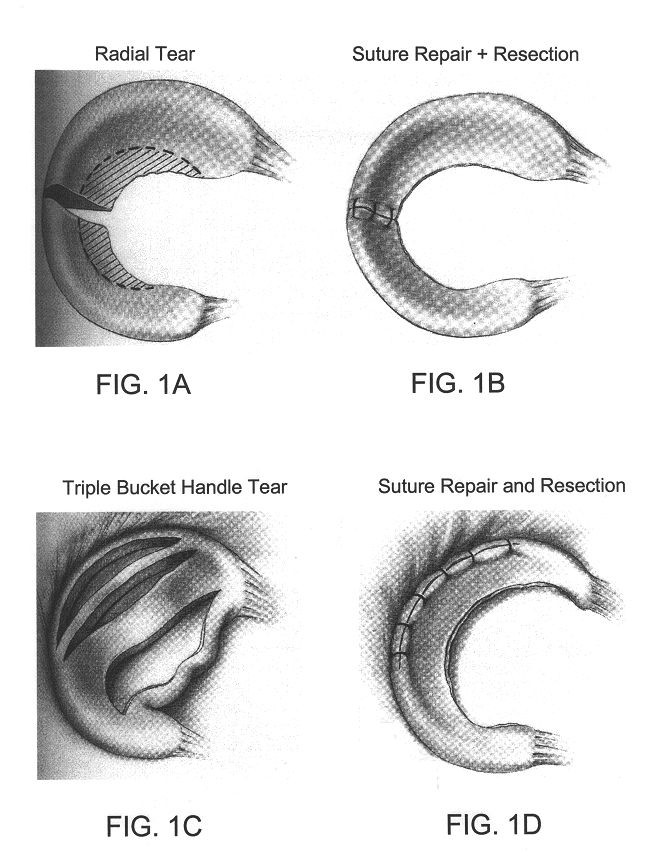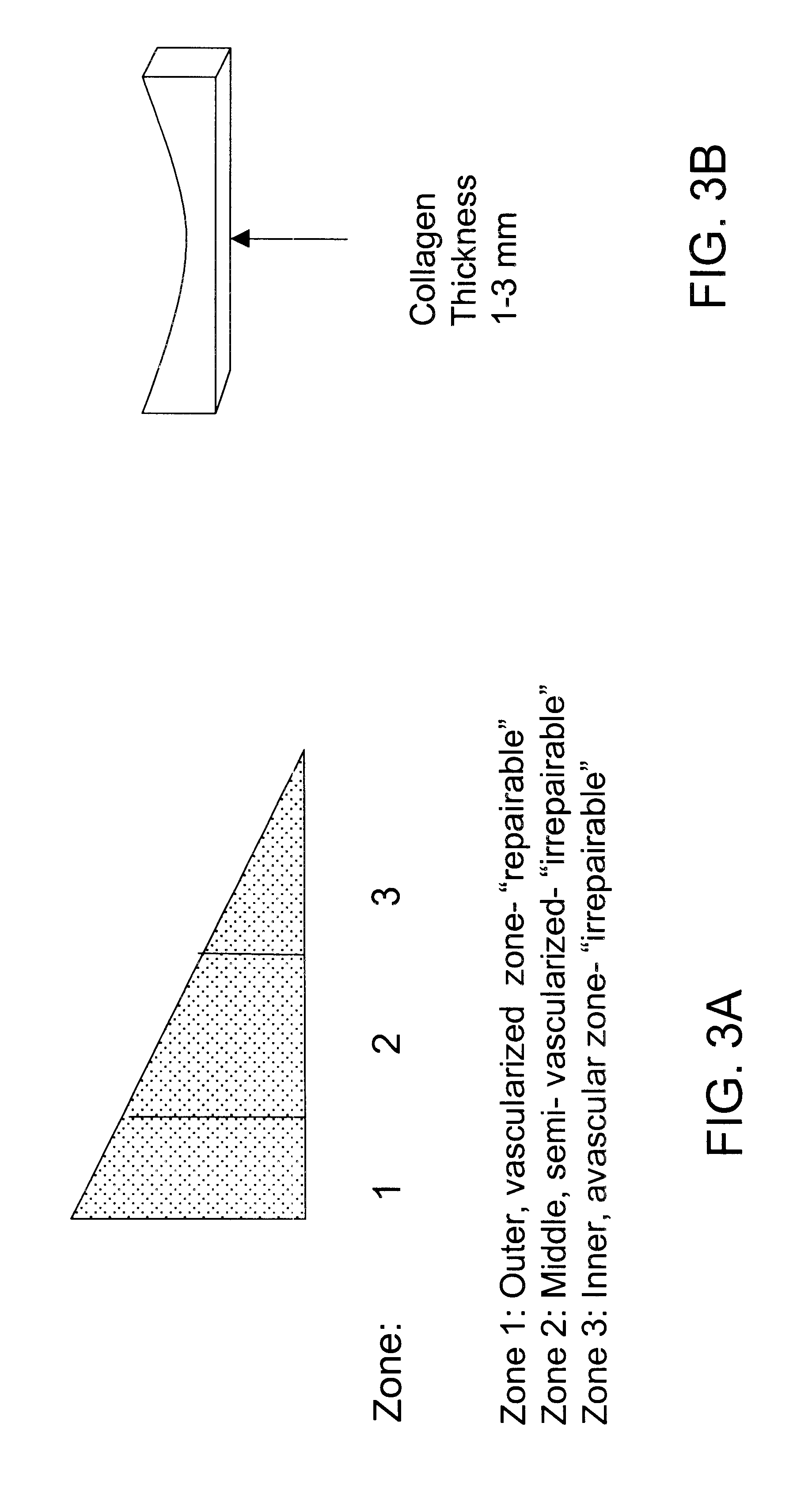Compositions for regeneration and repair of cartilage lesions
a cartilage and collagen technology, applied in the direction of joint implants, peptide/protein ingredients, powder delivery, etc., can solve the problems of reduced knee stability and knee locking, limited natural healing capacity, and avascular tissue, and achieve the effect of improving the rate and/or quality of repair
- Summary
- Abstract
- Description
- Claims
- Application Information
AI Technical Summary
Benefits of technology
Problems solved by technology
Method used
Image
Examples
first embodiment
In the present invention, a cartilage-inducing composition includes a mixture of proteins which includes: transforming growth factor .beta.1 (TGF.beta.1), bone morphogenetic protein (BMP)-2, BMP-3, and BMP-7. The quantity of the TGF.beta.1 in the mixture is typically from about 0.01% to about 99.99% of total proteins in the mixture. The quantity of the BMP-2 in the mixture is typically from about 0.01% to about 10% of total proteins in the mixture, or from about 0.01 to about 1%, or from about 0.01 to about 0.1%, or from about 0.1 to about 1%, or from about 0.1 to about 10% of total proteins. The quantity of the BMP-3 in the mixture is typically from about 0.1% to about 15% of total proteins in the mixture, or from about 0.1 to about 1%, or from about 0.01 to about 15%, or from about 0.01 to about 1%, or from about 0.01 to about 0.1%. The quantity of the BMP-7 in the mixture is typically from about 0.01% to about 10% of total proteins in the mixture, or from about 0.01 to about 1%, ...
third embodiment
In the product of the present invention, a cartilage-inducing composition includes a mixture of proteins comprising: (a) a TGF.beta. protein; and, (b) at least one bone morphogenetic protein (BMP), wherein the ratio of the TGF.beta. protein to the BMP protein is greater than about 10:1. In this embodiment, the TGF.beta. protein can be any TGF.beta. protein, including TGF.beta.1, TGF.beta.2, TGF.beta.3, TGF.beta.4, TGF.beta.5, or mixtures thereof. In a preferred embodiment, the TGF.beta. protein is TGF.beta.1 or TGF.beta.2, with TGF.beta.1 being most preferred. The BMP protein can be any BMP protein, including, but not limited to, BMP-2, BMP-3, BMP-4, BMP-5, BMP-6, BMP-7, BMP-8, BMP-9, CDMP, and mixtures thereof.
Preferably, the ratio of the TGF.beta. protein to the at least one BMP protein in the mixture (w / w), is greater than about 10:1, and in one aspect, is greater than about 100:1, and in another aspect, is greater than about 1000:1, and in another aspect, is greater than about 1...
example 1
The following example demonstrates that a naturally derived mixture of proteins isolated from demineralized bovine bones (BP) induces spheroid formation and chondrogenesis in vitro in the mesenchymal precursor cell lines, 10T1 / 2 and C.sub.2 C.sub.12.
Murine C3H / 10T1 / 2 (ATCC No. CCL-226) embryonic mesenchymal stem cells and C.sub.2 C.sub.12 adult myoblast cells (ATCC No. CRL-1772; derived from leg muscle) were obtained from the American Type Tissue Collection. 10T1 / 2 and C.sub.2 C.sub.12 cells were proliferated in the presence of 10% and 15% FBS, respectively. Micromass cultures were performed as follows. Briefly, trypsinized cells were resuspended in media containing FBS at a concentration of 10.sup.7 cells / ml, and 10 .mu.l of cells were placed in the center of a 24 well microtiter tissue culture dish. After 2-3 hours at 37.degree. C., 1 ml of DMEM (for 10T1 / 2) or 1:1 DMEM:F-12 (for C.sub.2 C.sub.12) media containing 1% Nutridoma and various concentrations of BP (prepared as describe...
PUM
| Property | Measurement | Unit |
|---|---|---|
| Fraction | aaaaa | aaaaa |
| Fraction | aaaaa | aaaaa |
| Fraction | aaaaa | aaaaa |
Abstract
Description
Claims
Application Information
 Login to View More
Login to View More - R&D
- Intellectual Property
- Life Sciences
- Materials
- Tech Scout
- Unparalleled Data Quality
- Higher Quality Content
- 60% Fewer Hallucinations
Browse by: Latest US Patents, China's latest patents, Technical Efficacy Thesaurus, Application Domain, Technology Topic, Popular Technical Reports.
© 2025 PatSnap. All rights reserved.Legal|Privacy policy|Modern Slavery Act Transparency Statement|Sitemap|About US| Contact US: help@patsnap.com



